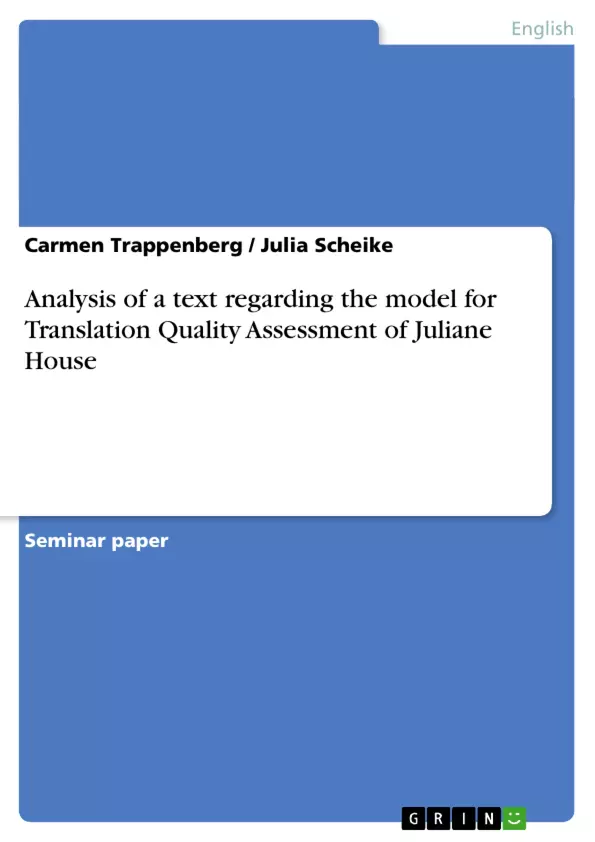In the following we will examine the quality of the German translation of Bram Stoker′s Dracula by the analysis-categories of Juliane House.
The texts used are:
Source text, in the following referred to as ST:
Bram STOKER, Dracula, ed. Michael Hulse (Köln, 1995)
Target text, in the following referred to as TT:
Bram STOKER, Dracula, 3rd ed. (Wien, 1993)
Juliane HOUSE, A model for translation quality assessment (Tübingen, 1981)
Juliane HOUSE, A model for translation quality assessment. A model revisited (Tübingen, 1997)
The novel Dracula was published in London for the first time in 1897 and was written between .
The translation used here is based on the German translation by Stasi Kull from 1967.
Inhaltsverzeichnis (Table of Contents)
- Introduction
- Field
- Tenor
- Mode
- Genre
- Statement of function
- Comparison ST - TT
- Statement of quality
Zielsetzung und Themenschwerpunkte (Objectives and Key Themes)
This paper examines the quality of the German translation of Bram Stoker's Dracula using Juliane House's analysis categories. The aim is to assess the translation's effectiveness in conveying the original text's meaning, style, and intended effects.
- Analysis of translation quality using Juliane House's model
- Comparison of source and target text in terms of lexical, syntactic, and textual features
- Examination of the translation's accuracy, fluency, and faithfulness to the original
- Exploration of the impact of language and cultural differences on the translation
- Assessment of the translation's success in achieving its intended purpose
Zusammenfassung der Kapitel (Chapter Summaries)
- Introduction: This chapter introduces the paper's topic, the texts under analysis, and the analytical framework. It provides contextual information about Dracula and its translation history.
- Field: This chapter explores the lexical features of the source and target texts, focusing on the use of language related to different fields such as travel, medicine, and social class.
- Tenor: This chapter examines the relationship between the author and the reader, and the impact of this relationship on the translation. It analyzes the stylistic features of the text and the translator's choices in rendering these features.
- Mode: This chapter focuses on the function of the text and its intended purpose. It examines the translation's success in conveying the original text's message and its impact on the reader.
- Genre: This chapter discusses the genre of the text and how the translation adheres to or deviates from genre conventions. It analyzes the translation's effectiveness in preserving the genre's distinctive features.
- Statement of function: This chapter presents a comprehensive analysis of the translation's overall function and its intended effects on the target audience.
- Comparison ST - TT: This chapter compares the source and target texts in detail, highlighting key similarities and differences. It analyzes the translator's choices and their impact on the translation's quality.
- Statement of quality: This chapter presents a final assessment of the translation's quality, taking into account all aspects of the analysis. It evaluates the translation's strengths and weaknesses and offers a conclusion about its overall success.
Schlüsselwörter (Keywords)
The key terms and focus topics of this paper include translation quality assessment, Juliane House's model, source text, target text, lexical analysis, syntactic analysis, textual analysis, genre analysis, cultural differences, and the German translation of Bram Stoker's Dracula. The paper explores the impact of these concepts on the overall effectiveness of the translation.
- Quote paper
- Carmen Trappenberg (Author), Julia Scheike (Author), 1998, Analysis of a text regarding the model for Translation Quality Assessment of Juliane House, Munich, GRIN Verlag, https://www.hausarbeiten.de/document/10810


